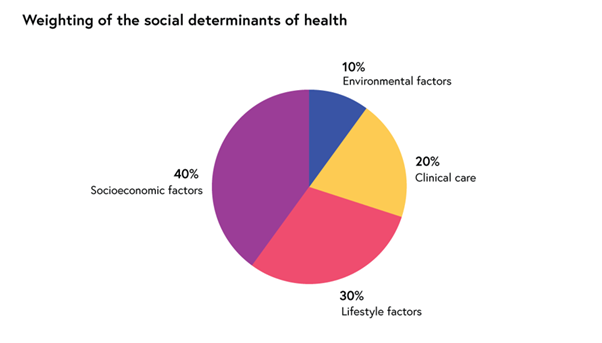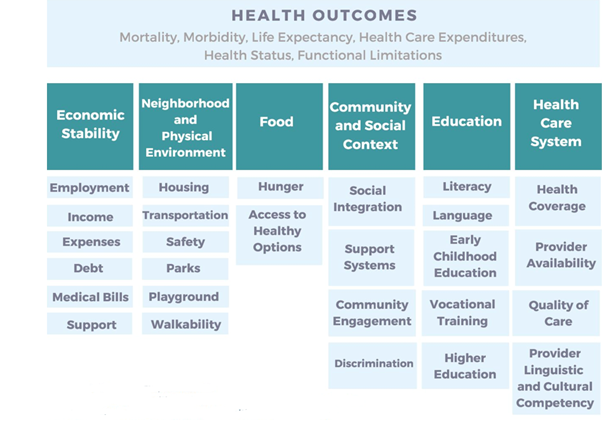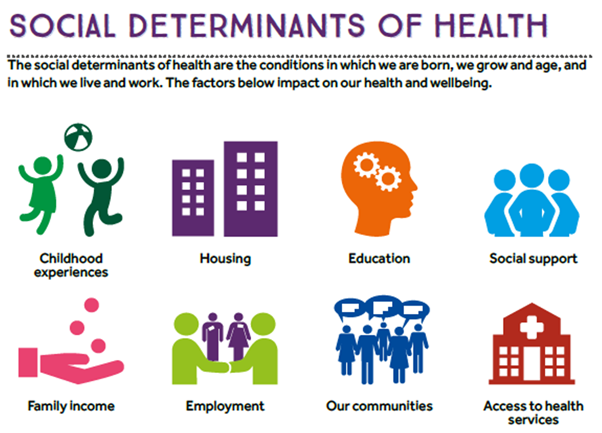Healthcare Assignment: An E-Portfolio on Social Determinants of Health
Question
Task:
To develop this healthcare assignment, you will choose 1 social determinant of health (social class, gender, age, race and ethnicity, disability, access to technology, employment, education, financial resources, housing, etc.) and will collect artifacts (photographs/images, audio/video files, maps, figures, graphics, written text, etc.) to show how they impact on health inequalities and contribute to understanding health outcomes.
Choosing your social determinant of health:
- Choose one social determinant of health (for example, gender, race/ethnicity, or age, migration, education, employment, housing, etc.) and relate it to health inequalities
- Choose three artifacts for your social determinant of health (artifact one, artifact two and artifact three) to illustrate the impact of that social determinant on health inequalities. Artifacts can be photographs, audio/video files, maps, figures, graphics, links, written text, etc.
- Write a short Commentary Analysis for each uploaded/included artifacts - How does the artefact included represent your social determinant and its impact on health inequalities?
Answer
Introduction A key to happiness and prosperity is good health. Thus, it is stated in this healthcare assignment that every society has to ensure that its people are healthy. This will enhance their economic conditions and overall wellbeing. In order to improve the health outcomes, the social determinants of health should be taken into consideration (Felner et al, 2018). There are various social determinants like social class, race, age, gender, employment, education, ethnicity, access to technology, disability, housing, financial resource, etc. which contribute towards the economic progress, wealth and prosperity of individuals and society as a whole. The healthy populations are considered to be more productive; they save and live more. In this e-portfolio, certain artefacts will be collected on employment, a social determinant of health. The e-portfolio will show how the artefacts represent employment as a social determinant of health. It will also show how it impacts the health inequalities and provides a better idea about the health outcomes.
Social determinant of Health
According to Kreshpaj et al (20200), employment is a very crucial social determinant of health. The health outcomes are dependent on the employment of an individual. Employment closely impacts the mental as well as physical health. It has been statistically proven that the people who have been unemployed over a long-term period are likely to have a lower life expectancy. The unemployed people are also seen to have poorer health conditions than the ones who are in a job. The employment does not only affect the individuals but also the society at large.
As per Islam (2019), studies have shown that employment or re-employment is linked directly with better mental health condition. The employment is a mental health determinant as it reduces the psychological stress, minimizes the depression and also lowers the level of anxiety. In case of unemployed individuals or those who have lost their jobs (very common during the Covid-19 pandemic) the mental health condition is poor. Their level of depression, anxiety and psychological distress is way higher.
Hale and Viner (2018) stated that employment is considered to be a social determinant of health as employment gives a person a sense of identity in the society. The person who is employed follows a routine and maintains better health status. Extreme work conditions could also lead to increase in the level of stress. Long working hours or no work both are equally bad for the health as it deprives the person of sleep, increases their blood pressure and causes heart diseases.
Impact of Employment on Health Outcomes
The employment rates and health outcomes are associated as suggested by Bodin et al (2020). The higher and healthy life expectancy is strongly correlated with the higher rate of employment. This is mostly seen in men over women. At an average, out of every 10 percentage points the higher the rate of employment, the greater and healthier would be the life expectancy, which is around 5 years more.
As opined by Hahn, Truman and Williams (2018), the unemployment has always had a negative impact on the health outcomes. The self-rated health and unemployment are seen to have close links. The unemployment adversely affects the health of men. There is a need for strong social networks to ameliorate the health conditions of the unemployed and those who have lost their jobs for health reasons. Unemployment not only causes stress but also has long term physiological impacts. These have a negative consequence on the mental health of people causing them low self-esteem, high anxiety and depression (Muntaner, 2018).
Employment & Health Inequality
As per Nowotny and Kuptsevych?Timmer (2018), employment is closely linked with health inequality. The unequal distribution of wealth, income and power can cause unequal health status across the society. The increase in the quantity as well as quality of work or employment can facilitate improving the health outcomes and reducing the level of health inequalities. The unemployment is linked with a wide range of health inequalities and health risks. These health inequalities are caused by the events like losing a job and becoming unemployed involuntarily. This could also be caused by reduced income levels, higher level of poverty and increased deprivation. The ill health imposes certain risks, which magnify once the duration of being unemployed increases.
The unemployment has a devastating impact on the health of the people in the society (Hynie, 2018). Therefore, employment is a very significant social determinant of health. The health inequalities increase and health outcomes worsen when social class distinction plays an important role in the society. The psychological well-being of the unemployed men increases This aggravates the possibilities of parasuicide, anxiety and depression (Muntaner, 2018).
Artefact One: Quantitative
The below given quantitative artefact shows different social determinants of health. Each of the social determinants of health have different weightage. For instance, the environmental factors have only percent impact on the health condition or outcome of the people of the society. On the other hand, clinical care has 20 percent weightage while lifestyle factors have 30 percent weightage. This suggests that lifestyle of a person highly impacts the health outcomes of a person. Clinical care comes into play only when a person falls sick. Thus, it is of lesser significance. Clinical care would not be required if one maintains their lifestyle and health conditions. The socioeconomic factors however are given the maximum weightage as social determinants of health (Felner, Dudley and Ramirez-Valles, 2018). The employment is a socio-economic factor which impacts the health outcomes of the people within the society. Thus, this determinant is given 40 percent weightage.

(Source: Hahn,Truman and Williams, 2018)
Artefact Two: Qualitative
The below given image is a qualitative artefact which shows the various determinants of health. These determinants impact the health outcome of the people. The determinants include economic stability in which employment plays a vital role. Besides, there are other factors like food, neighbourhood and physical environment, community and social context, health care system and education.

(Source: Hale and Viner, 2018)
Artefact Three: Qualitative
The third given artefact is also a qualitative artefact in the form of an image. This shows the various social determinants with which a person grows, lives, works, etc. These social determinants impact the well-being and health of the people in the society. Few of the determinants illustrated in the image include education, employment, childhood experiences, housing, social support, family income, communities, access to health care services, etc.

(Source: Bodin et al, 2020)
Self-Narrative
There are several social determinants of health. Few of these include ethnicity, age, gender, race, disability, education, social class, housing, employment, resources, etc. Among these, employment is one of the most significant social determinants of health. I chose employment as the social determinant of health for this study because I find it vital and more important than the other determinants. In fact, employment conditions could be modified to enhance the health status and outcomes, which is the reason why I take keen interest in this determinant. This is not only a social determinant but also an economic determinant of health. The health inequalities are created due to unequal distribution of income earning opportunities. When the employment opportunities are restricted the health services become unaffordable, leading to poorer health conditions.
I have personally been impacted by this social determinant of health. The employment or better to say unemployment as a social determinant of health has left a strong impact on my life. There was a time when my family was going through a huge financial crisis as my father had lost his job. During that time, my sister was suffering from a serious ailment. The medical expenses were increasing with each passing day. She was hospitalized and the bills were getting out of our affordability range. Thus, we had to finally bring her back home and take care of her at home in whatever informal way possible. This led to worsening of her health condition. We would have lost her if one of our well-wishers hadn’t stepped forward to help us financially for the treatment.
The reason why employment as a social determinant intrigues my interest is because this specific determinant can be altered or modified to improve the health outcomes. In case of lack of employment opportunities, new employment options could be created so that the people have jobs and can afford medical expenses. The employers could also provide medical insurance to cover the health care expenses of the employees. This would again be an advantage for those who have a job. The consistent flow of income makes it easier for a person to afford the health care expenses.
Moreover, employment has a direct link with an individual’s physical and mental health. This is an information which I have gained from thorough study on this topic. I always knew employment and income makes it easy to afford medical and health care services. However, the direct impact of employment, rather unemployment on health was unknown to me until I undertook this research. I came to know while carrying out the research for the e-portfolio that the people who are employed have a better mental health. This is reflected in better physical health as well compared to the ones who have no jobs. The unemployed people are seen to be more depressed, suffering from anxiety and other psychological disorders, which reflect in their poor physiological conditions. The people who work in poor working conditions also suffer from ill health.
Conclusion
It can be concluded from this e-portfolio that employment is a very important factor or social determinant which impacts the health conditions of the people in the society. Through a steady source, one can improve their health outcomes. Employment directly affects the health inequalities. Thus, improving the employment condition within the society or economy could improve the health status. The quantitative as well as qualitative artefacts used in this e-portfolio clearly depict that employment has a strong correlation with health. Thus, this social determinant needs to be prioritized while dealing with health issues and its unequal distribution across the people of the society.
References
Bodin, T., Ça?layan, Ç., Garde, A.H., Gnesi, M., Jonsson, J., Kiran, S., Kreshpaj, B., Leinonen, T., Mehlum, I.S., Nena, E. and Orellana, C., 2020. Precarious employment in occupational health–an OMEGA-NET working group position paper. Scandinavian journal of work, environment & health. 2020; 46 (3): 321-9.
Felner, J.K., Dudley, T.D. and Ramirez-Valles, J., 2018. “Anywhere but here": Querying spatial stigma as a social determinant of health among youth of color accessing LGBTQ services in Chicago's Boystown. Social Science & Medicine, 213, pp.181-189.
Hahn, R.A., Truman, B.I. and Williams, D.R., 2018. Civil rights as determinants of public health and racial and ethnic health equity: health care, education, employment, and housing in the United States. SSM-population health, 4, pp.17-24.
Hale, D.R. and Viner, R.M., 2018. How adolescent health influences education and employment: investigating longitudinal associations and mechanisms. J Epidemiol Community Health, 72(6), pp.465-470.
Hynie, M., 2018. The social determinants of refugee mental health in the post-migration context: A critical review. Healthcare assignment The Canadian Journal of Psychiatry, 63(5), pp.297-303.
Islam, M.M., 2019. Social determinants of health and related inequalities: confusion and implications. Frontiers in public health, 7, p.11.
Kreshpaj, B., Orellana, C., Burström, B., Davis, L., Hemmingsson, T., Johansson, G., Kjellberg, K., Jonsson, J., Wegman, D.H. and Bodin, T., 2020. What is precarious employment? A systematic review of definitions and operationalizations from quantitative and qualitative studies. Scandinavian journal of work, environment & health, 46(3), pp.235-247.
Muntaner, C., 2018. Digital platforms, gig economy, precarious employment, and the invisible hand of social class. International Journal of Health Services, 48(4), pp.597-600.
Nowotny, K.M. and Kuptsevych?Timmer, A., 2018. Health and justice: framing incarceration as a social determinant of health for Black men in the United States. Sociology Compass, 12(3), p.e12566.












